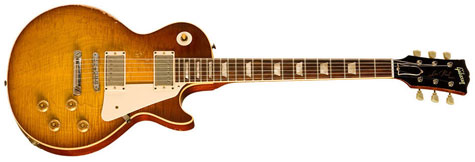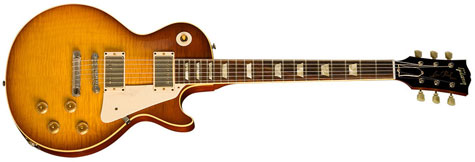Specs on, Pics of the Pearly Gates Replica

Pearly replica, aged version
Lots of websites have been jumping on the recently issued, and “lovingly crafted,” Gibson Pearly Gates replica, but haven’t mentioned the most important stuff: specs and pics! So here they are.
But first, the MSRPs of the three versions of this bad-boy:
- Aged by Tom Murphy, Signed by Billy Gibbons (50 total) = $25,882
- Aged by Tom Murphy (50 total) = $15,294
- Vintage Original Spec finish (250 total) = $11,176
That’s right, those prices are in U.S. greenbacks. Gibson to world: “Damn the recession!” When the Goldman Sachs boys are done buying most of these guitars, maybe you can afford one of the ones left if you do that cash-for-clunkers thing.
![gibson_pearly_aged_back1 [Aged version, back]](http://www.woodytone.com/wp-content/uploads/2009/07/gibson_pearly_aged_back1.jpg)
Aged version, back
Specs
(Pics are throughout, all from Gibson.com. For some reason Photoshop lightened the color a bit on save.)
In addition to premium (I assume) mahogany for the body and neck and hand-selected maple tops, there is:
![gibson_pearlyreplica_tops_realpgright1 [Left, Pearly replica top; right, actual Pearly]](http://www.woodytone.com/wp-content/uploads/2009/07/gibson_pearlyreplica_tops_realpgright1.jpg)
Left, Pearly replica top; right, actual Pearly
> All nickel hardware
> Lightweight aluminum string-over stopbar tailpiece
> Vintage Kluson-style tulip tuners
> Gold top hat control knobs
> The one-piece neck has a medium 1959 rounded profile and a long-neck tenon
> Period-correct CTS potentiometers and bumble bee capacitors
> Pickups are stock Seymours: “To replicate his studio tone in a live setting Billy turned to Seymour Duncan, who after carefully examining and analyzing the original pickups developed the appropriately named Pearly Gates humbuckers, which are as close to sonically matching the original pickups as anyone will ever get. The results are truly amazing. These popular conduits of tone – used by such brilliant players as Dickey Betts and Warren Haynes – are slightly hotter than your normal, everyday humbucker. According to the Seymour Duncan Web site, the Pearly Gates humbuckers are ‘sweet, but slightly rude, with great sustain and a bright top end that make harmonics jump out of the guitar.'”
> Nitrocellulose finish: “Applying a nitrocellulose finish to any Gibson guitar is one of the most labor-intensive elements of the guitar-making process. A properly applied nitro finish requires extensive man hours, several evenly applied coats, and an exorbitant amount of drying time. But this fact has never swayed Gibson into changing this time-tested method, employed ever since the first Gibson guitar was swathed with lacquer back in 1894. Why? For starters, a nitro finish dries to a much thinner coat than a polyurethane finish, which means there is less interference with the natural vibration of the instrument, allowing for a purer tone. A nitro finish is also a softer finish, which makes it easily repairable. You can touch up a scratch or ding on a nitro finish, but you can’t do the same on a poly finish. In addition, a nitro finish is very porous in nature, and actually gets thinner over time. It does not “seal” wood in an airtight shell—as a poly finish does—and allows the wood to breathe and age properly.”
No word on fret size, nut type (presumably bone) or whether the guitars will be strung with Billy Gibbons’-favorite 7-gauge strings (doubtful).
Notable
> What does VOS mean? “All VOS (Vintage Original Spec) series guitars will use a proprietary process that includes unique steps for staining, wet-sanding, and hand-rubbing; subsequently the guitars reflect what a well-cared for 40-year-old guitar looks like. The result is a remarkable patina that will delight even the most discriminating enthusiast.”
> Here’s the link to Pearly on Gibson.com.

VOS version
Category: Billy Gibbons, Gibson, Les Paul, Seymour Duncan













